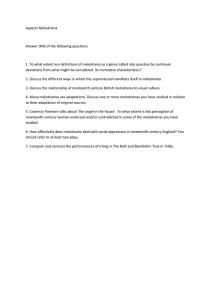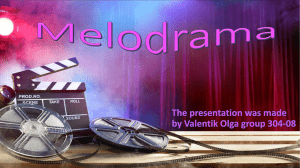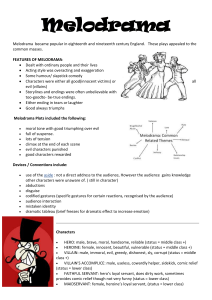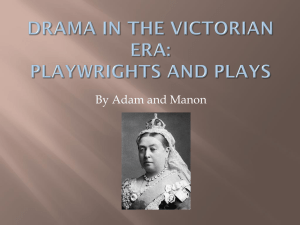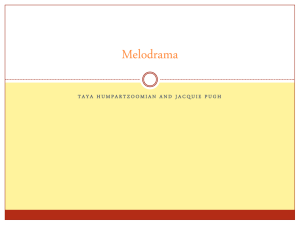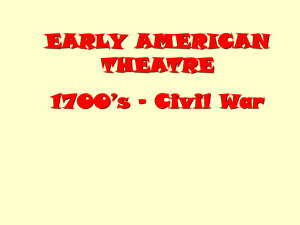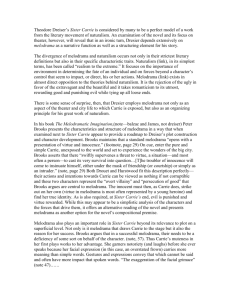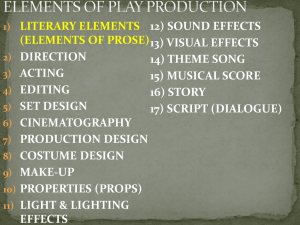19th Century Theatre
advertisement
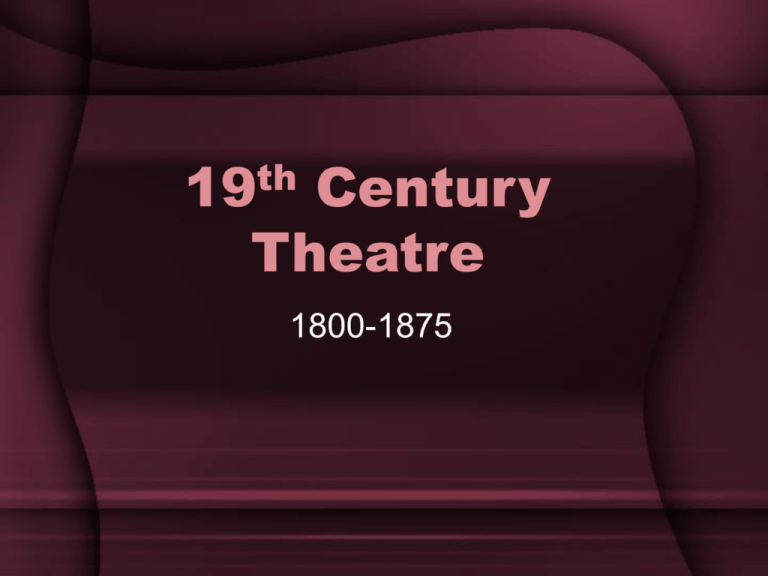
th 19 Century Theatre 1800-1875 Historical Background • Industrial Revolution – Replacement of hand tools and human power by machinery and the development of the factory and factory system • Middle Class continuing to rise in power – Legislatures passing reforms to benefit the middle class • Influential people who disturbed traditional beliefs: – Karl Marx – Charles Darwin – Sigmund Freud Neoclassic Ideals • All drama must teach a moral lesson Unities • – Unity of Time • – Unity of Place • – One location only Unity of Action • • Dramatic action should not exceed 24 hours One central story – no subplots Decorum – All characters should behave in ways based on their gender, age, profession, social status Neoclassical • Verisimilitude – All drama must be “true to life” • NO ghosts, apparitions, or supernatural, fantastical events or things • Genres – Tragedy only about royalty • Must end badly/tragically – Comedy only about common people • Must end happily – NEVER mix comic elements and tragic elements Ideals dictated how plays were written and produced Romanticism • Stressed strong emotion as a source of aesthetic experience, placing new emphasis on such emotions as trepidation, horror, and the awe experienced in confronting the sublimity of nature • Rejected the neoclassical rules – Actually they rejected all artistic rules, suggesting that genius creates its own rules • More interested in creating mood and atmosphere than developing believable plots or depth of character • Did not believe in purity of genre – Considered all subject matter appropriate for the stage • Patriotism, nationalism, revolution and armed struggle for independence became popular themes in the arts of this period • Romantic hero was frequently a social outcast who quested for justice, knowledge, and truth Romanticism in Art • Music – Ludwig van Beethoven – Frederic Chopin • Literature – – – – Edgar Allan Poe Nathaniel Hawthorne Emily Dickinson Lord Byron Third of May 1808 by Francisco Goya Melodrama flourishes… • • • • Melodrama means “song drama” or “music drama” The first melodrama was performed in France in 1798 Plays were written putting emphasis on surface effects that would evoke suspense, fear, nostalgia, and other strong emotions “If you believe, as the Greeks did, that man is at the mercy of the gods, then you write tragedy. The end is inevitable from the beginning. But if you believe that man can solve his own problems and is at nobody's mercy, then you will probably write melodrama.” … and then dies • Melodrama died in 1915, according to theatre history textbooks – The truth is that the entertainment industry moved to film to distribute the melodramas for WAY cheaper than doing plays – A lot of the same people who created the theatre industry moved it to Los Angeles • Melodrama is the standard Hollywood model – “Melodramatic” suggests a style that is over the top, extremely emotional, larger than life Elements of Melodrama 1. Music • Underscore, not like a musical with singing and dancing 2. Morally polarized characters • Good guys versus bad guys 3. Heroine • Damsel in distress who must be saved by the hero 4. Happy Ending • Cosmic justice has to prevail – good has to win over bad Elements of Melodrama 5. Sidekicks • Usually a best friend – comic relief • • 6. 7. Sidekicks are comic and the situation is serious Scooby Doo – Fred is the hero, Daphne is the heroine, Velma is Daphne’s sidekick, Shaggy is Fred’s sidekick and Scooby Doo is Shaggy’s side kick Mixture of suspense and comedy Physical conflict • Always ends in a final physical conflict – a battle of good and evil; like a showdown in a western Elements of Melodrama 8. Exotic Locations – – 9. New places to escape Set things in the past, the future or far away places Animal Acts – Liked including animals on stage 10. Technology, stage combat, stunts and special effects – – Trains on stage The purpose is to keep an audience interested from start to finish Melodramas of the 19th Century • Uncle Tom’s Cabin (1853) by George L. Aiken – adapted from Harriet Beecher Stowe’s novel • The String of Pearls (1847) by George Dibdin Pitt – Play on which Stephen Sondheim based his musical Sweeney Todd (1979) One of the best examples of a Modern Day Melodrama: Example of a Melodrama Pirates of the Caribbean: The Curse of the Black Pearl 1. 2. 3. 4. 5. 6. 7. 8. 9. 10. Stirring musical score by Klaus Badelt Good and Evil: Will Turner vs. Capt. Barbosa Damsel in need of rescue: Elizabeth Happy ending: curse lifted, Jack Sparrow saved from the noose, Will and Elizabeth together Sidekick: What better comic relief than Captain Jack Sparrow? Lots of action and witty dialogue… we all know we love to quote it. Physical conflict: Big battle with swords and cannons and the British Navy fighting an undead army Exotic Location: upon the beautiful blue waters of the Caribbean Animal Acts: Jack the Monkey and Mr. Cotton’s Parrot Special Effects: Disney worked very hard on turning those men into the Digital Undead. More on Melodramas • Melodramas can be socially or politically progressive, but it is always culturally conservative – Melodrama follows the mainstream cultural expectations of society Women are portrayed, culturally, today as successful in business, succeeding in a man's job, multi-tasking – • They can beat up the guys, but they haven't neglected their feminine side, beautiful, tender and emotionally vulnerable and still get rescued – Ex: Elizabeth Swann Other Melodramas Popular Entertainments • Minstrel Shows – Was the first truly American entertainment consisting of comic skits, variety acts, dancing, and music, performed by white people in blackface – Portrayed and lampooned blacks in stereotypical and often disparaging ways: as ignorant, lazy, buffoonish, superstitious, joyous, and musical. – Minstrel songs and sketches featured several stock characters, most popularly the slave and the dandy. • These were further divided into sub-archetypes such as the mammy, her counterpart the old darky, the provocative mulatto wench, and the black soldier. Wild West Shows • • For more info, go to YouTube and look under “Buffalo Bill’s Wild West Show” • In 1884, the outdoor Wild West Show had authentic cowboys, Indians, buffaloes, horses, sharpshooters and melodramas The show itself consisted of a series of "historical" scenes interspersed with feats of showmanship, sharp shooting, racing, or rodeo style events. Native Americans figured prominently in many of the scenes, often shown attacking whites in historical situations with Buffalo Bill or one of his colleagues riding in and saving the day – Buffalo Bill and his performers would re-enact the riding of the Pony Express, Indian attacks on wagon trains, and stagecoach robberies. The show typically ended with a melodramatic re-enactment of Custer's Last Stand in which Cody himself portrayed General Custer Many authentic western personalities were part of the show: – Sitting Bull and a band of twenty braves – Annie Oakley and her husband Frank Butler put on shooting exhibitions – 'Calamity Jane' Burlesque • In the 19th Century, the term "burlesque" was applied to a wide range of comic plays, including non-musicals – Beginning in the 1840s, these works entertained the lower and middle classes in Great Britain and the United States by making fun of (or "burlesquing") the operas, plays and social habits of the upper classes • Evolved out of the spontaneous/improvisational tradition of commedia dell’arte – Spoofed Greek tragedies and Shakespeare – Eventually, performers turned to more general satirical comedy, and burlesque became a platform for mocking the bourgeoisie – Used comedy and music to challenge the established way of looking at things • It was not until the 20th century that this form became a combination of comedians and strippers Circuses • P.T. Barnum (1810-1891) developed exhibits in the American Museum in New York City – Exhibited human curiosities and presented variety acts and plays in a theatre built for family audiences • Joyce Heth, who he said was 140 years old • The “Fiji Mermaid”, which was the head of a monkey sewn onto the body of a fish • Tom Thumb, the midget – In 1850s, he became involved with the circus, a touring version of his museum and advertised it as “the greatest show on earth” Acting Theory: Delsarte • Much of the acting between 1800 and 1875 was based on stereotypical physical gestures and vocal patterns taught by Francois Delsarte • Believed actors could convey emotions and inner thoughts through specific, pre-established gestures and body movements • Scientific approach to acting, consistent with the scientific spirit of the age – System was rejected by modern realists because it assumed that all human beings reacted the same way Scene Design: The Box Set • Consists of flats hinged together to represent a room • Had practical elements, such as doors and windows
